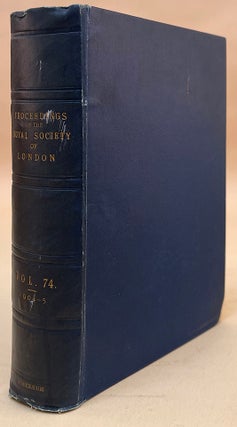On the conversion of electric oscillations into continuous currents by means of a vacuum valve.
Publisher Information: London: 1905. First edition.
The Beginning of Electronics
Fleming, John Ambrose (1849-1945). On the conversion of electric oscillations into continuous currents by means of a vacuum valve. In Proceedings of the Royal Society. 74 (1905): 476-487. Whole volume, 8vo. [66, variously paginated], 580pp. Plates, text illustrations. Later library buckram, very minor rubbing and wear. Book-label and stamps of the Liverpool Athenaeum.
First Edition. Fleming’s paper introducing the basic principle of the two-electrode vacuum tube or diode marked the beginning of electronics. Before the development of the transistor the vacuum tube became the first switch used in the earliest electronic computers. Using vacuum tubes as switches, the first general purpose electronic computer, the ENIAC, operated 10,000 times the speed of a human computer. By comparison, the Harvard Mark 1, which used electromechnical relays as switches, computed 100 times the speed of a human computer.
An electrical engineer and physicist who had worked with Thomas Edison's company in London, and a consultant to Guglielmo Marconi, Fleming invented and patented the two-electrode vacuum-tube rectifier, which he called the oscillation valve. This was called a thermionic valve, vacuum diode, kenotron, thermionic tube, or Fleming valve. Fleming' diode was an essential step in the development of radio, In 1906 Lee de Forest introduced a third electrode called the grid into the vacuum tube. The resulting triode could be used both as an amplifier and a switch. In this form the vacuum tube was used in radio receivers and radar until it was superseded by solid state electronics more than 50 years later. The first electronic computer, the ENIAC, used 18,000 vacuum tubes as switches. Vacuum tubes were used in electronic computers until the late 1950s, and they are still manufactured today for specialty analogue Hi-Fi equipment. Printing and the Mind of Man 396.
Book Id: 40296Price: $2,750.00


